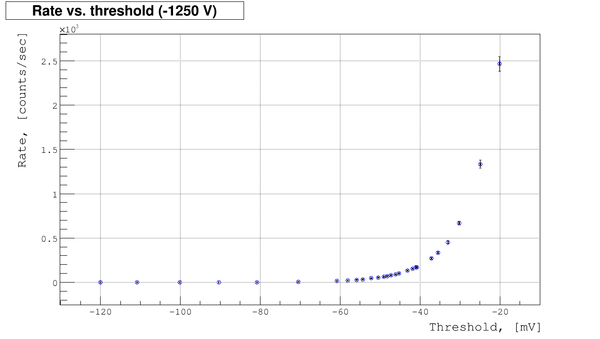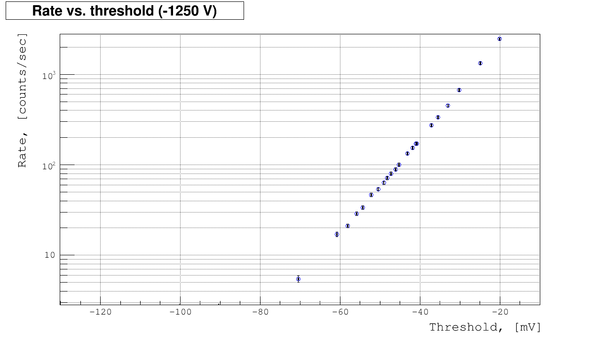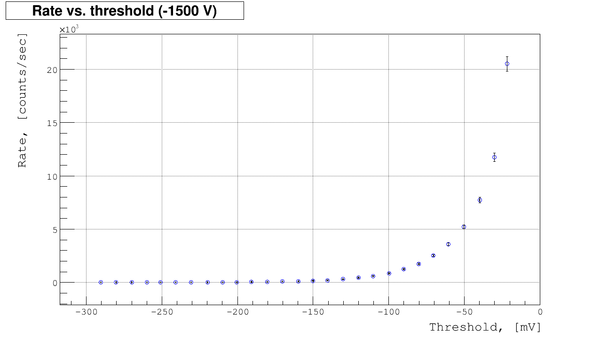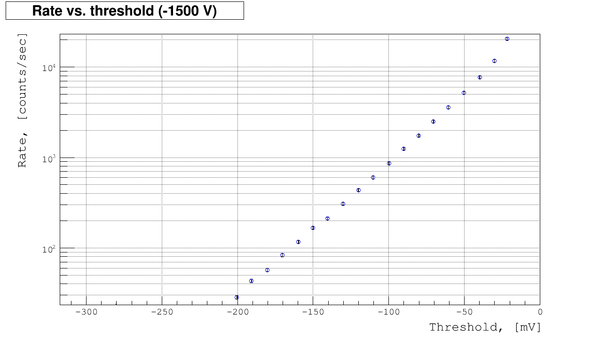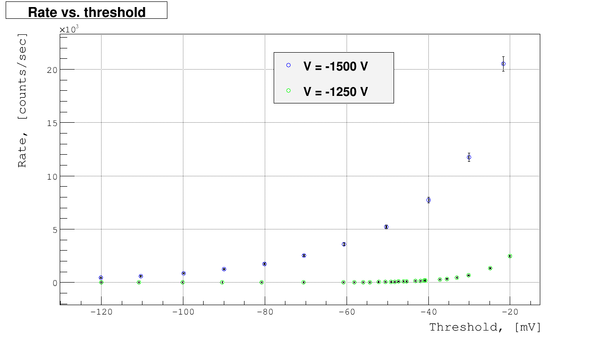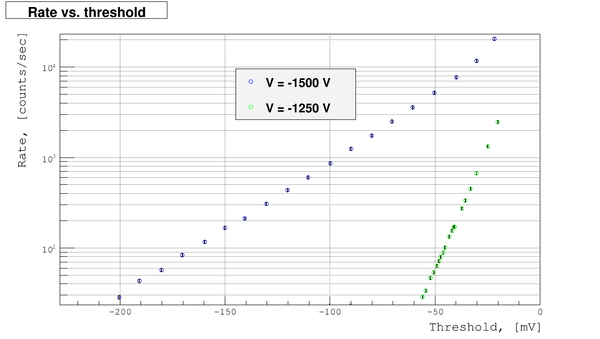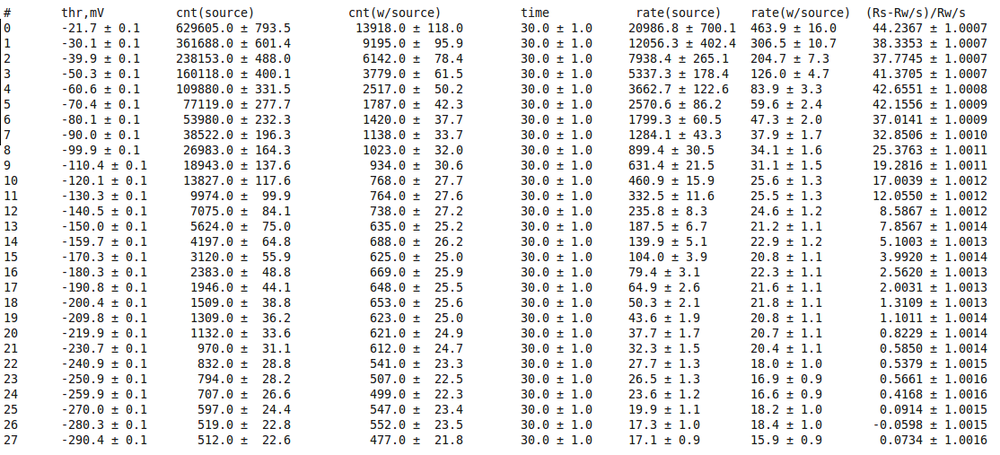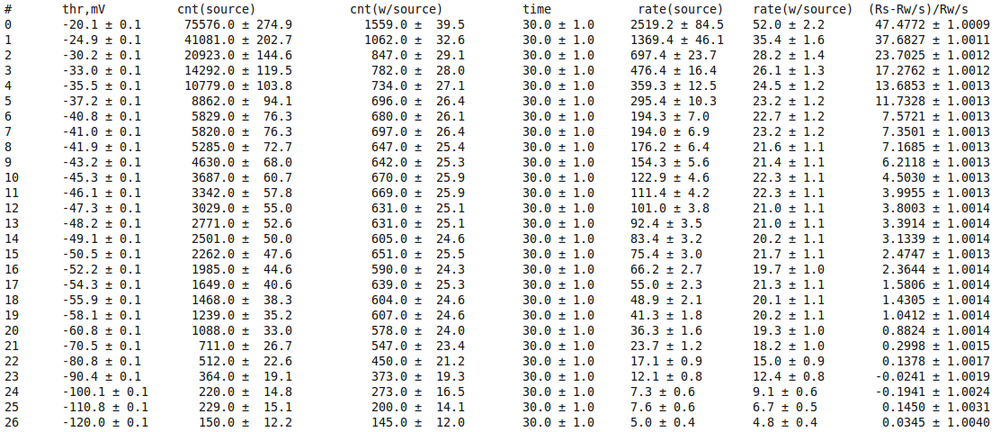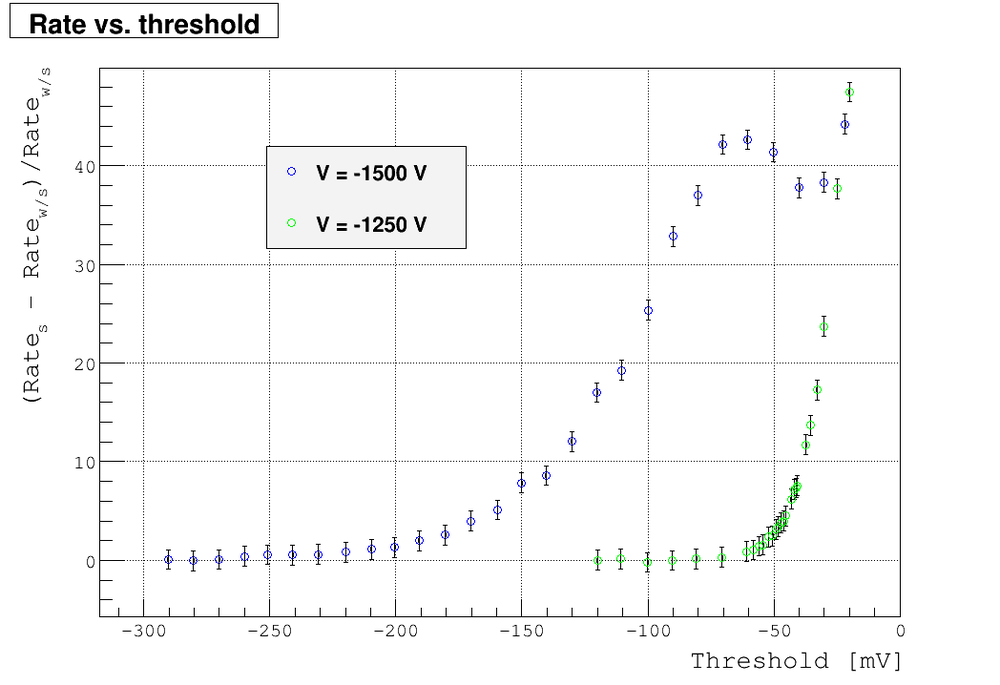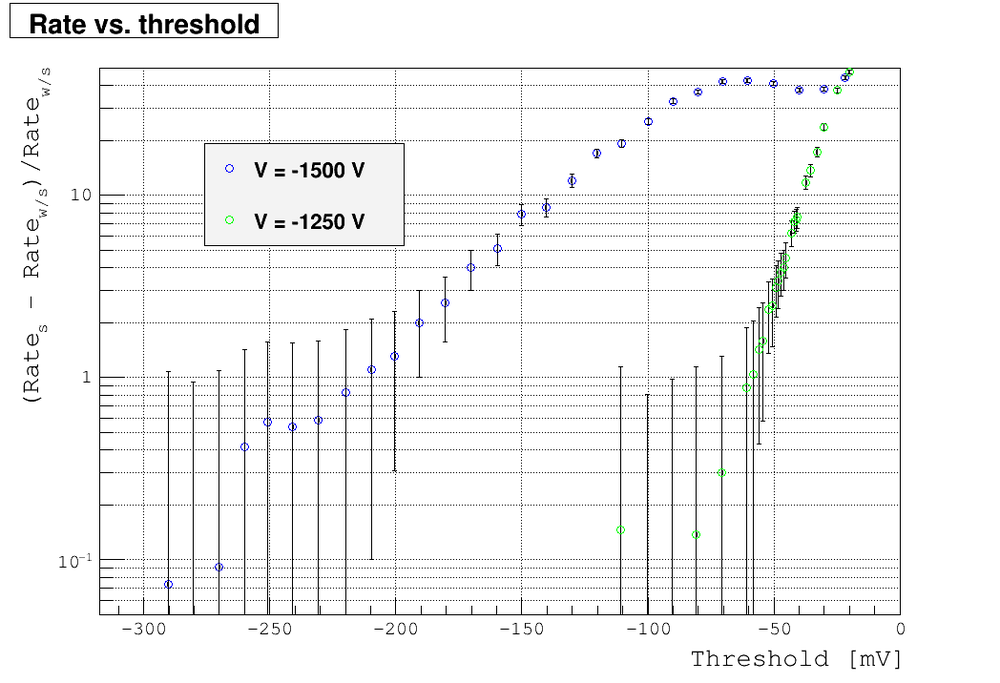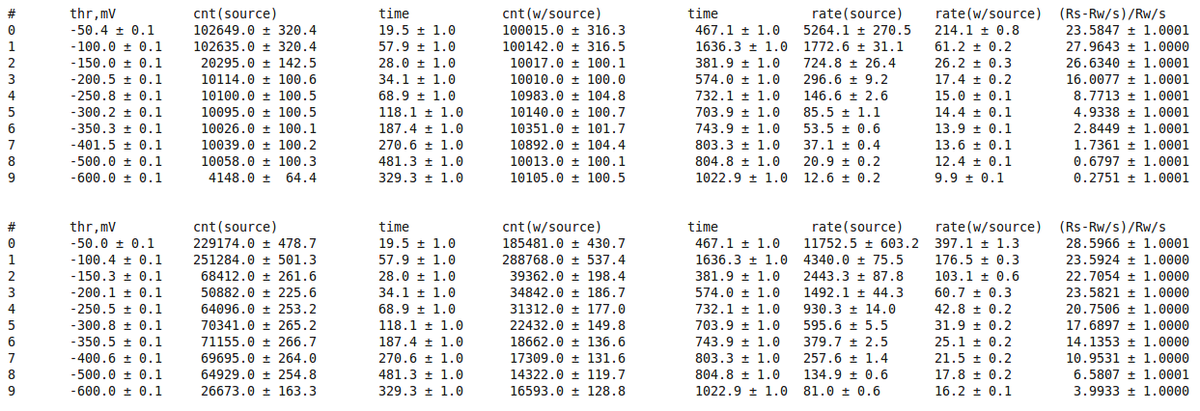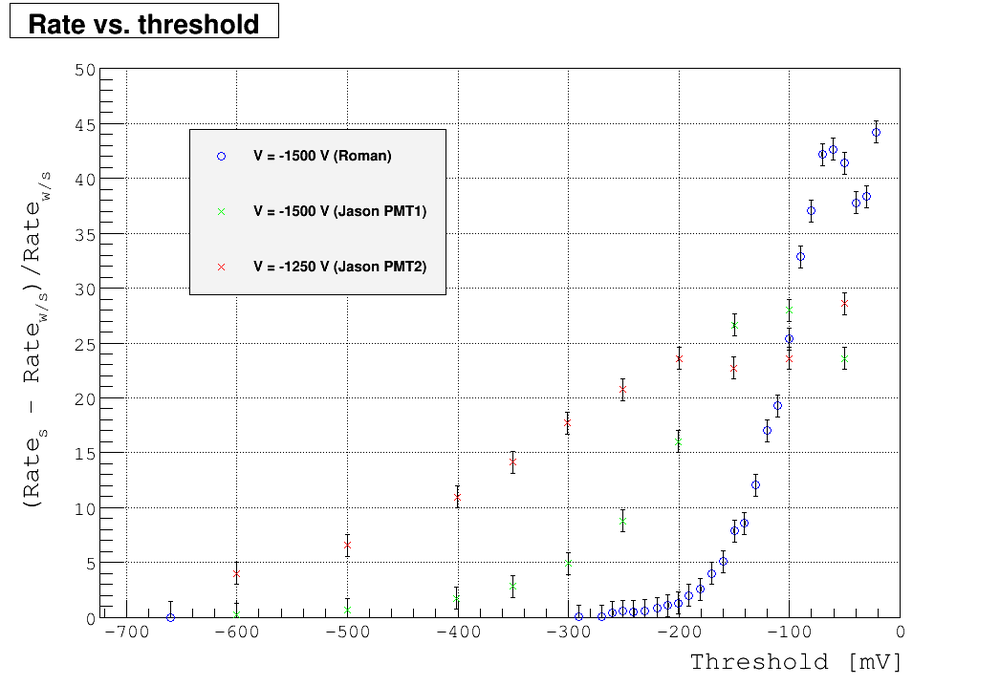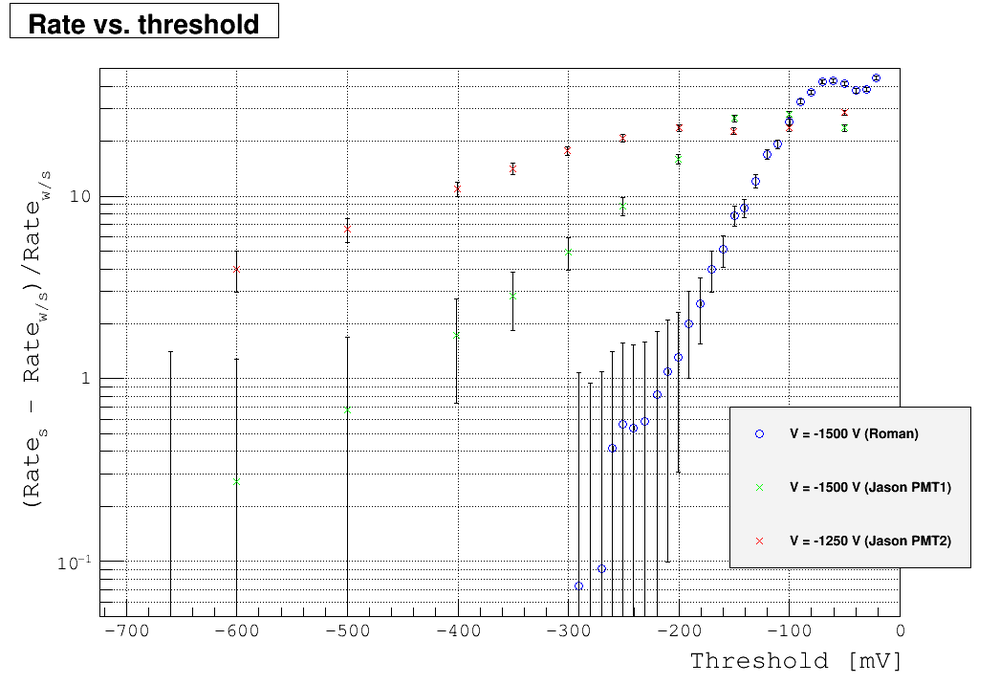Difference between revisions of "05/19/2011 n's detector threshold calibration source/(w/source)"
(Created page with '[https://wiki.iac.isu.edu/index.php/N%27s_detector_calibration Go Back] Because is something wrong I decided to measure the counts rate as function of threshold energy. Maybe m…') |
|||
| (41 intermediate revisions by the same user not shown) | |||
| Line 1: | Line 1: | ||
| − | [https://wiki.iac.isu.edu/index.php/ | + | [https://wiki.iac.isu.edu/index.php/Roman_measurements go back] |
| − | + | Below are my counts rate measurements as function of threshold voltage for n's detector. The source was CF252. The distance between source and n's PMT was about 50 cm. It was 1 PMT set up detector and experiment was hold in LDS on May 19 2011. | |
| − | + | ==First the counts rate was calculated as:== | |
| − | + | <math>\mbox{Rate} = \frac{N_{\mbox{source}} - N_{\mbox{w/source}}}{\mbox{Time}}</math> | |
| + | First I did my calibration for power supply voltage -1250 V: | ||
| − | + | [[File:Det1 calibraton source 1250V.png | 600 px]] [[File:Det1 calibraton source 1250 log.png | 600 px]] | |
| − | |||
| − | |||
| − | |||
| − | |||
| − | |||
| − | |||
| − | |||
| − | | | ||
| − | |||
| − | <math>\frac{ | + | Second I did my calibration for power supply voltage -1500 V: |
| + | |||
| + | [[File:Det1 calibraton source 1500V.png | 600 px]] [[File:Det1 calibraton source 1500 log.png | 600 px]] | ||
| + | |||
| + | |||
| + | And bellow I overlay both cases (-1250 V and -1500 V) | ||
| + | |||
| + | [[File:Det1 calibraton source 1250 1500.png | 600 px]] [[File:Det1 calibraton source 1250 1500 log.png | 600 px]] | ||
| + | |||
| + | |||
| + | '''There are no any plateaus, so what is the threshold should be?'''. Or maybe we are need to look at something different. | ||
| + | |||
| + | |||
| + | |||
| + | ==Let's recalculate all data using the formula:== | ||
| + | |||
| + | <math>\mbox{Ratio} = \frac{R_s - R_{w/s}}{R_{w/s}}</math> | ||
| + | |||
| + | Below my data and calculations for the case of -1500 V power supply voltage: | ||
| + | |||
| + | [[File:Table 1500V.png | 1000px]] | ||
| + | |||
| + | Below my data and calculations for the case of -1250 V power supply voltage: | ||
| + | |||
| + | [[File:Table 1250V.png | 1000px]] | ||
| + | |||
| + | |||
| + | And below I overlay my results (linear scale): | ||
| + | |||
| + | [[File:Det ratio lin.png | 1000px]] | ||
| + | |||
| + | and in log scale: | ||
| + | |||
| + | [[File:Det ratio log.png | 1000px]] | ||
| + | |||
| + | |||
| + | There are two important conclusions at least for this type of PMT was used: | ||
| + | |||
| + | # The desirable threshold is about -50 mV | ||
| + | # The power supply voltage is as expected -1500 V (there are no plateau for -1250 V) | ||
| + | |||
| + | |||
| + | |||
| + | ==Let's compare with what Jason did (at different place,different time and different PMT):== | ||
| + | |||
| + | Below are Jason's data and calculations: | ||
| + | |||
| + | [[File:Table Jason.png | 1200px]] | ||
| + | |||
| + | And below I overlay my and Jason's results (linear scale): | ||
| + | |||
| + | [[File:Det ratio1 lin.png | 1000px]] | ||
| + | |||
| + | and in log scale: | ||
| + | |||
| + | [[File:Det ratio1 log.png | 1000px]] | ||
| + | |||
| + | |||
| + | |||
| + | Looks different. | ||
| + | *PMT? | ||
| + | *location? | ||
| + | |||
| + | |||
| + | |||
| + | |||
| + | [https://wiki.iac.isu.edu/index.php/05/19/2011_n%27s_detector_threshold_calibration_source/%28w/source%29 go up] | ||
Latest revision as of 19:01, 24 May 2012
Below are my counts rate measurements as function of threshold voltage for n's detector. The source was CF252. The distance between source and n's PMT was about 50 cm. It was 1 PMT set up detector and experiment was hold in LDS on May 19 2011.
First the counts rate was calculated as:
First I did my calibration for power supply voltage -1250 V:
Second I did my calibration for power supply voltage -1500 V:
And bellow I overlay both cases (-1250 V and -1500 V)
There are no any plateaus, so what is the threshold should be?. Or maybe we are need to look at something different.
Let's recalculate all data using the formula:
Below my data and calculations for the case of -1500 V power supply voltage:
Below my data and calculations for the case of -1250 V power supply voltage:
And below I overlay my results (linear scale):
and in log scale:
There are two important conclusions at least for this type of PMT was used:
- The desirable threshold is about -50 mV
- The power supply voltage is as expected -1500 V (there are no plateau for -1250 V)
Let's compare with what Jason did (at different place,different time and different PMT):
Below are Jason's data and calculations:
And below I overlay my and Jason's results (linear scale):
and in log scale:
Looks different.
- PMT?
- location?
